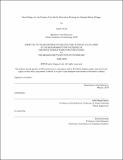New villages for the people of the North : relocation strategy for Alaskan native villages
Author(s)
Lim, Justin H. (Justin Heejoon)
DownloadFull printable version (74.11Mb)
Alternative title
Relocation strategy for Alaskan native villages
Other Contributors
Massachusetts Institute of Technology. Department of Architecture.
Advisor
Adèle Naudé Santos.
Terms of use
Metadata
Show full item recordAbstract
The existing coastal native Alaskan villages are facing the direct impacts of global warming, in particular due to disappearing ice sheets and rapidly thawing permafrost. The impacts ultimately result in erosion of the shorelines, flooding of the riverbanks, and destabilization of foundations - costing in billions of dollars in maintenance and replacement of homes and infrastructure. More importantly, they create imminent threats to lives of the natives and others that occupy the territory. Relocation has been favored by these villages under threats, but without a lead agency and a comprehensive vision, nearly all of the relocation plans have been delayed for nearly a decade by the lack of funding and the complex requirements from the various public and private agencies that cannot be complied or completed by the villagers. The US Government Accountability Office (GAO) had provided a report that identified 31 villages that were under the threats of global warming in 2009. The report further identified four villages, Shishmaref, Kivalina, Newtok, and Shaktoolik, that called for relocation of the entire village. Today, these four villages still remain at their current locations and continue to be challenged by the threats caused by flooding and erosion without any major interventions. This thesis project proposes a new relocation village at a resource-rich area eleven miles south from Shishmaref. Protected from the global warming factors, the new village defines its territory with a peripheral wind/snow fence that creates its own a micro climate by sheltering the village inside from the harsh wind and snow all year around and turns it into positive renewable energy through wind turbines and solar panels. The village's center, shared by the four villages mentioned above, is located at the intersection of the major infrastructure components of the airplane, water barges, and natural resources - all funded by the new collective funding mechanism that challenges the current linear funding mechanism that fails to individually relocate each village.
Description
Thesis: S.M., Massachusetts Institute of Technology, Department of Architecture, 2018. This electronic version was submitted by the student author. The certified thesis is available in the Institute Archives and Special Collections. Cataloged from student-submitted PDF version of thesis. Includes bibliographical references (page 208).
Date issued
2018Department
Massachusetts Institute of Technology. Department of ArchitecturePublisher
Massachusetts Institute of Technology
Keywords
Architecture.